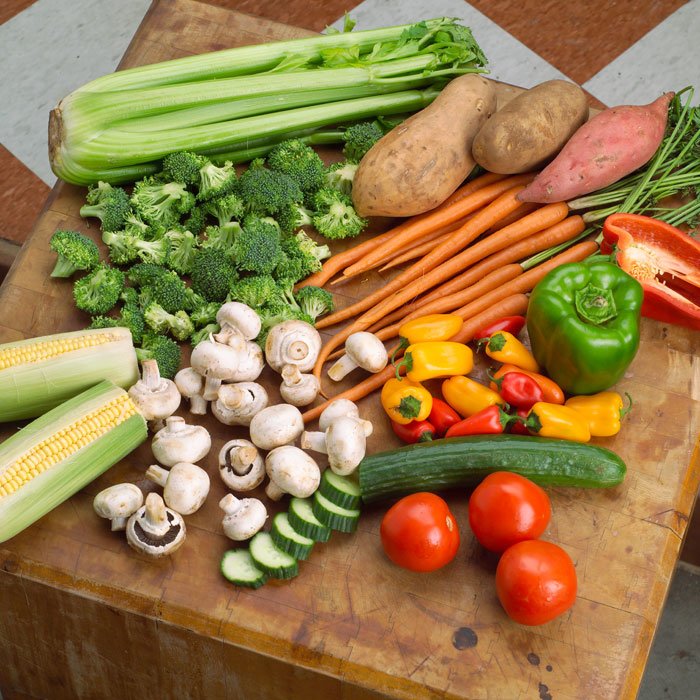It's a fact: most of us hate eating vegetables.
Since early childhood, most of us have told to eat vegetables because they're "good" for us. Usually, the vegetables in question were boiled, colorless, lifeless and tasteless vegetables like lima beans—or even worse—brussel sprouts.
The dinner-time pattern was always the same: dinner was served, we eagerly ate the meat and potatoes from our plates, and then came the showdown: the vegetables sat untouched on the plate until the very end, and stared us down like a nemesis awaiting the final conflict—the final clash of wills.
It's no surprise, then, that most of us see eating vegetables as an inconvenience and disdainful chore. But, there is good news: vegetables can look good, can taste good and can dramatically improve your health and your results in the gym. It all comes down to being creative and changing your perspective because, believe it or not, vegetables may be just as important as protein for overall health and muscle building.
Veggies 101
Vegetables are herbaceous plants that have a savory taste. By contrast, fruits are an extension of a main plant and typically have a sweet taste.
Vegetables are divided into five classes:
- Dark green vegetables
- Orange vegetables
- Dry beans and peas
- Starchy vegetables
- Other vegetables
Dark green vegetables include broccoli, collard greens, leafy lettuce, kale, spinach, watercress and other green and leafy plants.
Orange vegetables include sweet potatoes, carrots, pumpkins and a number of different species of squash.
Dry beans and peas include black beans, kidney beans, soy beans, split peas and tofu, and other types of beans and pea species.

Starchy vegetables include vegetables like corn, potatoes and green peas.
Other vegetables that are hybrids of two vegetables listed above or that do not belong to the other listed categories include such vegetables as asparagus, beets, cabbage, cauliflower, eggplant, onions, tomatoes, celery and cucumbers.
Each class of vegetables have different characteristics, different nutritional profiles and offer different health benefits.
Veggie Benefits...
Vegetables are rich in vitamins and minerals and have many benefits. While almost everyone knows that they should eat vegetables because they are good for us, it's not often that bodybuilders really stop to think about the specific benefits that vegetables provide.
Here are three characteristics that make vegetables powerful:
- They are low in calories
- They are high in fiber
- They are packed with vitamins and pigments
Here are some of the most important health benefits of eating vegetables:
Overall Health...
Vegetables enhance your overall health by supporting a strong immune system. Vegetables are rich in vitamins and minerals (vitamins C, B, D and A) and are highly concentrated with pigments like chlorophyll (found in green vegetables), caretenoids (found in yellow and orange vegetables) and anthocyanins (found in red and blue vegetables).
Unfortunately, many of the vitamins, minerals and pigments in vegetables are water-soluble and are not stored by the body, so you must eat vegetables several times daily to get the most benefit.
Aging...
We now know that aging—growing old—is caused, at least in part, by free radical damage.1 Free radicals are highly reactive oxidants that damage your muscles, cells, organs and DNA.
Vegetables are rich in antioxidants that scavenge your body for free radicals and eliminate them—preventing them from damaging your muscles, cells, organs and DNA. In fact, not only do vegetables protect you from damage, but they also repair damaged DNA and help reverse free radical damage.2
As a result, it can correctly be said that eating vegetables can reverse ageing and make you younger!
Cardiovascular Health...
Eating vegetables is known to help reduce the risk of chronic disease conditions and cardiovascular diseases.
Mental Health...
In addition to giving you the nutrients that you need for overall health, vegetables give you the antioxidants that you need to protect your brain today and to help prevent age-associated mental decline.
One study aimed to assess the long-term effects of vegetable consumption on mental functioning and mental ability in later life.
The study lasted for a total of six years and examined 3700 adult participants aged 65 years or older. To assess the effects of vegetables on mental functioning and the rate of age-related mental decline, researchers had the participants complete a mental functioning test and a dietary intake document that recorded their food intake. Mental testing was repeated halfway through the study at the three year mark.
At the end of the study research study, researchers found that the participants in the study who ate approximately three servings of vegetables per day had a 40% slower rate of cognitive decline than participants of the same age who ate only one serving of vegetables daily.3
The best vegetables for protecting the brain and slowing cognitive decline were green leafy vegetables.
But that's not all. The research also shows that eating vegetables helps protect your brain by reducing your risk of stroke.
Fat Loss...
Vegetables are beneficial for fat loss because they contain vitamins and minerals that you need for a healthy metabolism; they're also high in fiber.
Eating high fiber vegetables promotes feelings of fullness and helps to normalize blood sugar levels. This results in a dramatic reduction in the overall number of calories that you eat, a reduction in body fat storage, protection against diabetes onset, and the reduction or elimination of hormonally-triggered food cravings. Eating vegetables will help improve your digestion and leave you full and satisfied.
At the same time, vegetables improve your energy efficiency and overall energy levels by boosting energy usage inside of muscle cells, so you'll burn fat and have more energy naturally.
Blood Pressure...
Hypertension (high blood pressure) is the silent killer that affects over 600 million people Worldwide. Many athletes also suffer from high blood pressure and don't even know it.
Vegetables help to promote a healthy blood pressure. This is due, primarily, to their high potassium content. Potassium is an electrolyte that helps to regulate blood pressure values. Potassium-rich vegetables include sweet potatoes, spinach and kidney beans.
Muscle Building...
As much as we'd all like to believe that protein alone builds muscle, it just isn't true; vegetables play a vital role in muscle building.
Vegetables contain many vital vitamins and minerals; some of the most important are calcium, folate (folic acid), vitamin C, vitamin D, vitamin E and vitamin A, and more. Together, the vitamins and minerals in vegetables are critical for proper and efficient muscle contractions, red blood cell production, inflammation control, cortisol response mediation, oxidative stress response, cholesterol synthesis and more.
Unfortunately, taking a vitamin simply isn't enough: it's vital to get the majority of these critical vitamins and minerals from vegetables themselves. Doing so increases absorption and reduces the vitamin and mineral elimination.
Make no mistake: If you skip the veggies, you'll cripple your recovery rate, and you wont grow an ounce of new muscle.
Vegetable Preparation
The way that you prepare your vegetables prior to eating them dramatically affects their nutritional value and the benefits that they may provide. And, if you're going to eat vegetables, it makes sense to prepare them so as to maximize their nutritional value and benefit.
To maximize nutritional value and benefit, it's recommended that you eat your vegetables raw; if eating your vegetables raw is not appropriate, possible or preferred, steam-cook them.
Many people boil their vegetables or cook them in a microwave, but this is not recommended because this can cause the breakdown of the vegetables cellulose structures and result in significant nutrient loss, thereby increasing the total percentage of "empty" calories being consumed as the vegetables lose nutritional value.
Eating your vegetables raw or steaming them will prevent the breakdown of the vegetables cellulose structures and will help retain maximum nutrients and pigments.
How Much Do I Need?
Many factors including your sex, your age and your physical activity level work together to determine your daily vegetable requirement.
Generally, men have a higher vegetable intake requirement than do women, simply because men tend to hold a greater percentage of their body mass as muscle tissue and are usually more physically active than their female counterparts.
However, for men and women 18 years of age and older, a vegetable intake of two to three cups daily is recommended. If you exercise several days per week, your vegetable intake requirements are higher and you should aim to consume approximately five cups of vegetables every day.
Final Thoughts...
Vegetables are important, and you can't grow without them. Vegetables pack a nutritional punch that fuels your body to build muscle and burn fat. But, their value isn't limited strictly to muscle building and fat burning—vegetables are good for you generally, and the great news is that they can look good and taste good, you just need to be creative.
Mix it up. Take advantage of the benefits that vegetables can produce by eating a wide variety of vegetables of every kind. In so doing you'll tale your nutrition and physique to new heights and you'll be healthier and grow faster than ever before.
References
- Bunker VW. Free Radicals, Antioxidants and Ageing. Med Lab Sci 1992;49:299.
- S Fan, Q Meng, K Auborn, T Carter, E M Rosen. BRCA1 and BRCA2 as molecular targets for phytochemicals indole-3-carbinol and genistein in breast and prostate cancer cells. British Journal of Cancer 94, 407 - 426 (13 Feb 2006).
- Associations of vegetable and fruit consumption with age-related cognitive change. Morris et al. Neurology.2006; 67: 1370-1376
